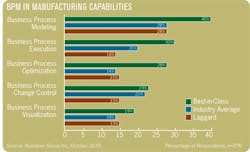Business Process Management Produces Manufacturing Benefits
Jan. 7, 2011
3 min read
At the same time, products, the overall value chain and the information technology (IT) ecosystem have all been subject to an unprecedented growth in complexity.To help manage this complexity, organizations are re-architecting static, rigid, form-fit processes to create an organization that can quickly adapt to changing market conditions. To accomplish this, Best-in-Class organizations are taking a Business Process Management (BPM) approach to their manufacturing operations, as well as incorporating Manufacturing Operations Management (MOM) into enterprise-level BPM strategies.A BPM approach to manufacturing operations involves taking a new look at how manufacturing processes are defined and supported by enabling technologies. For process definitions, organizations must analyze how work is performed, break down this work into the smallest repeatable steps possible, standardize these repeatable steps across the organization and build all work processes out of these process steps.To better understand how the most successful companies are executing this strategy, we did a recent study using four Key Performance Indicator (KPI) criteria to distinguish the performance between the Best-in-Class (top 20 percent performers) from Industry Average and Laggard Organizations.We found that Best-in-Class companies are able to release newer products to the market and deliver these products on time, while at the same time increasing productivity with an 89 percent Overall Equipment Effectiveness (OEE) rate and realizing a 5 percent increase in operating margin. This means that these industry leaders are not only able to deliver new products to the market but are also able to gain competitive edge in the marketplace by gaining higher operational efficiencies and operating margin.Focus on capabilitiesBest-in-Class companies are differentiating by taking a holistic approach in managing industrial business processes. Best-in-Class organizations are almost twice as likely as Laggard organizations (32 percent vs. 18 percent, respectively) to have industrial business processes that are reusable and easily deployable. Although implementing such a capability seems relatively benign, achieving such an environment can be quite a challenge. Generally, it requires well-defined work processes that have been standardized across the organization. Additionally, for this approach to be effective, the standardized work definitions must be granular, often going right down to the work itself and what operators, supervisors and managers do on a minute-to-minute basis. It is also important to note that defining work process in such a way can be quite laborious, and requires dedicated personnel. On the enabling technology side, organizations must develop a processes orchestration platform to define, model and execute these work processes. The platform must also ensure that the necessary data sources, applications, events and stakeholders are integrated into the process—preserving the value of legacy IT investments but also allowing for innovation and continuous improvement. To accomplish all this, organizations require a full suite of BPM capabilities. Each of these technology enablers plays a critical role in the overall success of an initiative, with some of the most likely to be deployed by the Best-in-Class highlighted in the figure.Clearly, Best-in-Class manufacturers are differentiating from their competition and gaining a competitive advantage by taking a Business Process Management (BPM) approach to their manufacturing operations. For a more in-depth analysis and real world case studies, please see Aberdeen’s November 2010 benchmark report, Business Process Management in Manufacturing: Paving the Way for Effective Collaboration.Matthew Littlefield, [email protected], is a Senior Research Analyst; Nuris Ismail, [email protected], is a Research Associate; and Mehul Shah, [email protected], is a Research Analyst, at Aberdeen Group Inc., in Boston.
Subscribe to Automation World's RSS Feeds for Columns & Departments
About the Author
Matthew Littlefield
Nuris Ismail
Sign up for our eNewsletters
Get the latest news and updates

Leaders relevant to this article:
